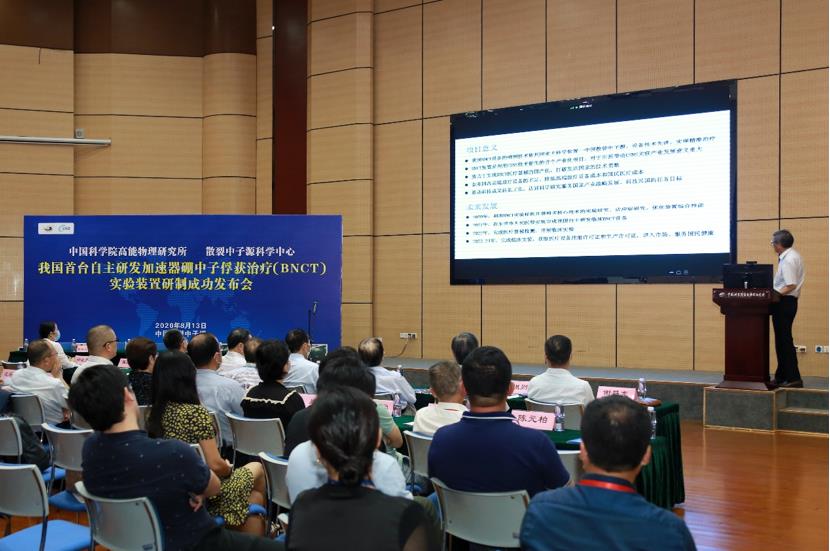China Builds First Accelerator-based Facility for Boron Neutron Capture Therapy Experiments
Date: 2020-08-20 Author:
The successful development of China's first accelerator-based facility for boron neutron capture therapy (BNCT) experiments was announced on Aug. 13 by the Dongguan Campus of the Institute of High Energy Physics (IHEP) of the Chinese Academy of Sciences.
IHEP also announced that it has started its first round of cell and small animal experiments using the facility. This project, which has received support from the Guangdong Province and city of Dongguan will lay a solid technical foundation for clinical trials, thus benefiting the domestic industrialization of BNCT facility and technical innovation in cancer treatment in China.
When Neutron Meets Boron
BNCT is regarded as one of the most cutting-edge techniques for cancer treatment in the world. It starts with injection of a tumor-localizing drug containing boron that accumulates in cancer cells. The patient is then irradiated with a neutron beam for less than an hour. When the boron in the cancer cells is hit by the neutron beam, a nuclear reaction occurs that creates alpha particles and lithium nuclei that destroy cancer cells precisely, without destroying surrounding healthy tissue.
"Alpha particles and lithium nuclei both have a very short range of impact, only one cell long, so they only kill the targeted cancer cells without damaging surrounding tissue." said Prof. LIANG Tianjiao, deputy director of the Dongguan Campus. LIANG noted that BNCT is an effective treatment for gliomas, melanomas and recurrent head and neck tumors, and is also a potential treatment for liver, lung, and pancreatic cancers.
"Patients can maintain a high quality of life after a short and flexible treatment course, without a huge economic burden," said LIANG, also pointing out that the development of a new generation of drugs will enable more types of cancer to be treated by BNCT.
The world's first accelerator-based BNCT facility and boron-containing drug were approved by Japan's Ministry of Health, Labor and Welfare in March. A hospital in Japan has since begun accepting patients, thus representing the first clinical application of BNCT in the world.
China Spallation Neutron Source Contributes Accelerator Technology
Accelerator technology from the China Spallation Neutron Source (CSNS), also housed on IHEP's Dongguan Campus, has been key to the development of the new BNCT facility. In past decades, the source of neutron beams for BNCT was often a nuclear reactor, thus slowing the development of this therapy.
Prof. FU Shinian, deputy manager of CSNS, said the development of BNCT was constrained for decades because most high-power neutron sources are installed in large-scale scientific laboratories, and only around 1,400 clinical trials using reactor-based BNCT have been conducted worldwide.
In contrast, the accelerator-based BNCT facility, being radiographic, can be installed more broadly, thus enabling a wider range of applications, such as customized BNCT treatments.
"If you can use accelerators to produce neutrons, it's easier to apply the technique in hospitals," said FU.
FU pointed out that the accelerators used in BNCT have much lower energy and use different target materials than the accelerator used in the CSNS project, which was completed in 2018 on the Dongguan Campus. He said the BNCT experimental facility successfully obtained its first neutron beam last year. FU noted that this milestone showed the "high quality and reliability of the processing, manufacturing, installation and commissioning of our equipment."
The BNCT project is the first industrial project to use accelerator technology from CSNS, showing how the large-scale scientific facility can contribute not only to basic research but also industrial development and technological innovation.
Clinical Trials Expected Soon
Researchers continue to optimize the BNCT facility to achieve the best performance. Plans have also been made to conduct more cell and animal experiments. The BNCT facility offers an experimental environment for the research and development of a new generation of boron-containing drugs. It will also contribute to subsequent clinical trials, especially in safety verification.
Based on its experience in developing the first BNCT facility, IHEP has cooperated with Dongguan People's Hospital in the R&D of a second facility. It is scheduled to begin a clinical trial soon and eventually carry out clinical treatments.
CHEN Yanwei, deputy director of IHEP, said the accelerator-based BNCT system will not only enhance China's role in developing large-scale medical systems, but also "benefit the whole society." "I am expecting a brand new era of cancer treatment to come soon," said CHEN.
 Press Release Conference
Press Release Conference
 Scale Model of BNCT
Scale Model of BNCT
 Radio Frequency Quadrupole Accelerator
Radio Frequency Quadrupole Accelerator



